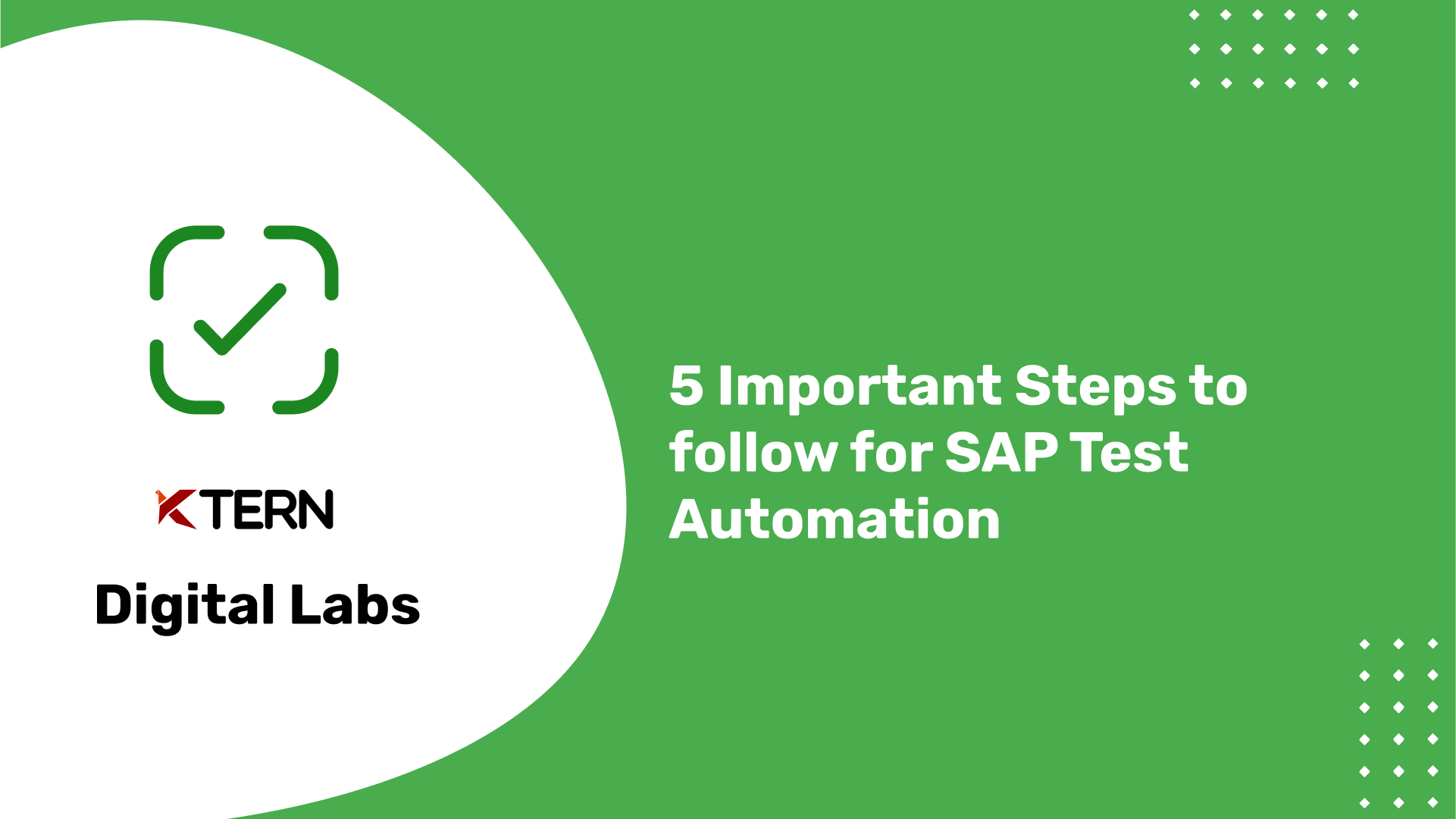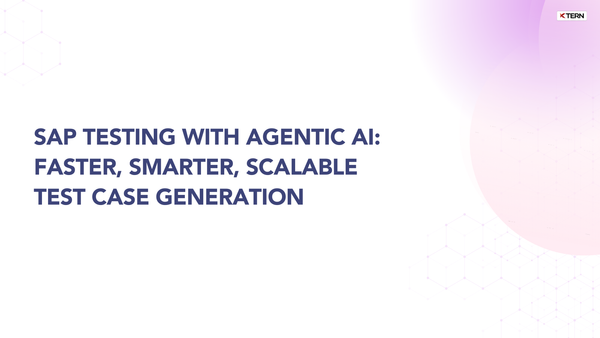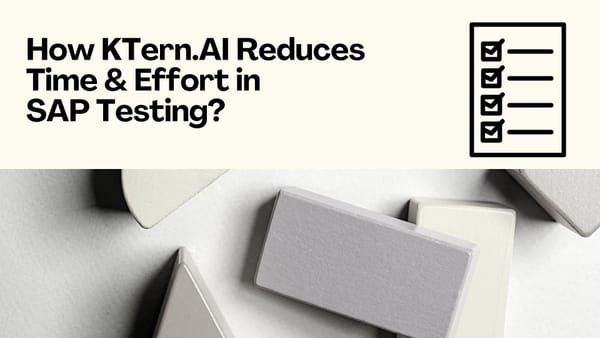5 Important Steps to follow for SAP Test Automation - 2025
Testing is critical for any SAP project. Comprehensive testing across business-critical applications involving change and process is always needed. However, with more and more departments utilizing IT and undergoing “digital transformation”, it is becoming difficult to standardize SAP test management and accelerate SAP test execution. To combat these difficulties, enterprises are now embracing SAP Testing Automation to ensure continuous delivery of change and quality. In this article, we’ll see 5 important steps to follow for SAP Test Automation.

Table of contents
- Steps to follow
- Step 1 – Identify critical business processes
- Step 2 – Choose the right business processes for Test Automation
- Step 3 – Capture the knowledge of key users for Test Automation
- Step 4 – Prepare test cases incorporating business process variants
- Step 5 – Test what must be tested
- Next Steps
Steps to follow:
| Steps | Description |
|---|---|
| Step 1 | Identify critical business process |
| Step 2 | Choose the right business process for automation |
| Step 3 | Capture knowledge of key users for automation |
| Step 4 | Prepare test case incorporating process variants |
| Step 5 | Execute and maintain automated test cases |
Step 1 – Identify critical business processes
Identifying the most critical business processes to be tested is the first step in scoping any test plan for SAP Test Automation. This requires business understanding and current data on business processes – derived from SAP systems and delivered with actionable insights.

This essentially means hard data from which we can infer the business processes that are most critical or used most often. In addition, multiple variants exist in the way each business process is fulfilled by different users. For scoping, statistics of business processes must include all usage variants and the respective usage frequency.
For the sake of an example, let’s take the following scenarios:
- Generating a report comparing delivery times and other parameters of different suppliers may not be test-worthy as it is only executed once a year when the suppliers’ agreements are up for renewal.
- Other processes like issuing a discount for example, might have variants, but only two of them are commonly used and therefore are worth testing.
You may now realize that the main scoping challenge is focusing effort and resources on business processes that must be tested instead of wasting them on irrelevant or outdated processes.
Unfortunately, the usual test automation solutions do not address this challenge – mainly because they are unable to map the raw business processes of SAP.
Some organizations use excel or other spreadsheet software to keep track of their business process data – but this is the absolute worst idea to follow for your testing strategy as they must be manually maintained and act as counterproductive measure to automation.
Key Take Away
A tool that can automatically generate business process data and present them as insights for test case creation, test execution, and test reporting is needed to identify the most business-critical processes to test. This would help to save time, effort, and the number of resources needed.
Step 2 – Choose the right business processes for Test Automation
Enterprise and especially testing teams should realize it is easy to get carried away during SAP Test Automation. It is easy to get into a rush and try to automate all business-critical processes.
Take a chill pill.
Findings state that most organizations automate only 30-40% of the business-critical processes. Therefore only 1/5th of the regression test cases consist of critical business processes.
But how do you know which test cases to automate? What factors must one consider? Is there anything such as useless automation? Is there a chance automation is causing more harm than good?
Businesses change often. This is the status-quo of the digital world. For example, a simple software purchase in an organization might need to go through multiple approvals along the length and breadth of the company depending on company policies.
In addition, policy changes could change rapidly based on management changes and many other factors. Automating and maintaining test cases for changes which happen too often is not feasible.
Likewise, some business processes can have multiple roots and dependencies. For example, the shipping vendor location may depend on geographic destinations, order cost, order channels, payment method, taxation, and available shipping partners.
Some dependencies may in turn represent many other business processes. Creating and maintaining automated test cases does not make sense in this case either.
So then, what is a good example of an ideal test case for automation, you ask? Test cases for automation should be lengthy, repetitive, and effort-intensive business processes. “Order creation” is one good example. Order to cash, Procure to Pay, Record to Report, Plan to Produce, Plan to Maintain, Fund Management are all good example for ideal test cases for automation.
Key Take-Away
When deciding on the test cases to automate, it is important to only automate the lengthy, static, labor-intensive test cases. Test cases which are dynamic or have multiple dependencies should be kept manual. A tool (like KTern) which utilizes Machine Learning and RPA can help automate test cases for the relevant business processes and eliminate the need for manually engineered test cases.
Step 3 – Capture the knowledge of key users for Test Automation
SAP is vast. SAP is old. SAP is filled with knowledge for those who search for them. Experience and all the “dog-years” worth of SAP knowledge are highly important. Testing acumen is important.

But, so is business process know-how. In fact, Capgemini World Quality Report lists ‘business process understanding’ as the key skill for Testing and Agile Quality Analysis according to 64% of the IT leaders whom they surveyed.
Identifying the right users, contacting them, and obtaining their application knowledge is a laborious activity and is time and effort intensive.
The key users prioritize their individual business objectives and it could be hard to get the right inputs from them.
Incentives could help key Users to devote time and get their input of recommended test scripts.
Alternatively, a functional analyst maybe needed to record and monitor usage data to pick the key users and get their inputs. If the employees are present in multiple locations across the globe, then the inputs of key users in each location is needed since there could be process variants from one location to another.
Key Take-Away
Identifying the right key users to prepare test scripts, following up with them to get the information, updating test scripts, and confirming the validity of test scripts are all difficult processes – especially since the production system is constantly changing.
The right tool (like KTern) will capture the right test cases along with the key users’ “know-hows” to resemble production and usage patterns. Provide instant information and real-time insights by removing batch jobs and manual effort.
Step 4 – Prepare test cases incorporating business process variants
Business processes are not constant. They vary from department to department, function to function, or location to location. For example, a business user in Italy may complete the same business process differently from that completed by a business user in the United States.
This may be attributed to different locations filling the system fields using different time and date formats, different metric systems, or other factors. This is where the coverage of automated test cases plays a major role.
The automated test cases should cover the frequently used variants of the relevant business cases.
Key Take-Away
The right test automation tool will generate test cases which incorporate the different variants of relevant business processes based on actual usage and up-to-date data from production.
Step 5 – Test what must be tested
Perhaps the most important part of automated testing is test case maintenance. Maintaining an accurate test case repository can result in critical savings in test case management. It is therefore important to maintain updated data sources which are current on usage patterns and variants.
A dynamic record of the change statistics of business processes helps to eliminate costs and produce meaningful savings for test case maintenance.
However, this seems to be easier said than done. Studies and surveys indicate that the biggest challenge for testing leaders is to maintain and update their test case library to resemble the scenarios in production.
Key Take-Away
The right test automation tool will help maintain an updated test repository and captures the business knowledge of the relevant test cases in order to maintain a near replica of production.

Next Steps
Now that you know the 5 steps to be followed for test automation, you might want to get a firsthand feel of KTern, its features for SAP Test Automation, and its other features which help automate and govern SAP projects from the start to finish. You can get started with the same at Demo App. Alternatively, if you would like a guided demo of the product from one of our product engineers, kindly get in touch with us by submitting a message at Contact Us.




